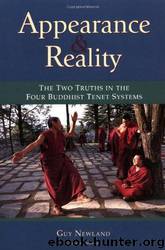Appearance & Reality: The Two Truths in the Four Buddhist Tenet Systems by Guy Newland

Author:Guy Newland
Language: eng
Format: azw3
Publisher: Snow Lion Publications
Published: 1999-08-25T00:00:00+00:00
Candrakirti, founder of the Middle Way Consequence system-the "highest rung" on the Gelukpa "ladder" of tenets-strongly differs with Bhavaviveka. Candrakirti and his followers say that Buddha did teach Mind Only doctrine, but did not hold it as his own final view. Candrakirti cites the Descent into Lanka Sutra:35
Although external objects do exist, the Buddha taught the non-existence of external objects for the sake of reducing attachment to what appear to be inherently existent (rang bzhin gyis grub pa, svabhavasiddha) external forms. In the Middle Way Consequence system, external objects exist conventionally, but neither minds nor their objects exist inherently. The emptiness of inherent existence is the ultimate truth that must be realized on a path to liberation. For some trainees, the easiest approach to realization of emptiness is via realization that there are no inherently existent external forms. Even though external objects do exist conventionally, the Buddha denied external objects for the sake of helping certain trainees to reduce their attachment to these apparently real external forms. Thus, for many, the Mind Only system is not an unnecessary mud-bath, but an invaluable stepping-stone to the Middle Way view.
For the sake of helping others, Buddha spoke words that are not literally true, but in teaching that there are no external objects and that all is "mind only," Buddha conveyed a key truth: mind is the principal creator of everything. By training our minds in ethics, meditative stabilization, and wisdom, we gradually gain control over the type of bodies and environments we are creating. Finally, each of us will create a pure land and become a buddha.
Proponents of the Middle Way Consequence system do not regard the refutation of external objects as literally acceptable. They argue that consciousnesses and their external objects are interdependentneither exists without the other. Thus, if there were no external objects there would be no consciousnesses. The externality of objects is a legitimate conventional understanding of the world. Unlike the perception of objects as inherently existent, the perception of objects as external is not refuted by yogic analysis. Like everything that exists at all, external objects exist in conventional terms (tha snyad du yod).
Download
This site does not store any files on its server. We only index and link to content provided by other sites. Please contact the content providers to delete copyright contents if any and email us, we'll remove relevant links or contents immediately.
The remains of the day by Kazuo Ishiguro(8814)
Tools of Titans by Timothy Ferriss(8211)
Giovanni's Room by James Baldwin(7188)
The Black Swan by Nassim Nicholas Taleb(7009)
Inner Engineering: A Yogi's Guide to Joy by Sadhguru(6722)
The Way of Zen by Alan W. Watts(6502)
Asking the Right Questions: A Guide to Critical Thinking by M. Neil Browne & Stuart M. Keeley(5627)
The Power of Now: A Guide to Spiritual Enlightenment by Eckhart Tolle(5603)
The Six Wives Of Henry VIII (WOMEN IN HISTORY) by Fraser Antonia(5394)
Astrophysics for People in a Hurry by Neil DeGrasse Tyson(5130)
Housekeeping by Marilynne Robinson(4328)
12 Rules for Life by Jordan B. Peterson(4249)
Double Down (Diary of a Wimpy Kid Book 11) by Jeff Kinney(4204)
The Ethical Slut by Janet W. Hardy(4172)
Skin in the Game by Nassim Nicholas Taleb(4161)
Ikigai by Héctor García & Francesc Miralles(4123)
The Art of Happiness by The Dalai Lama(4063)
Skin in the Game: Hidden Asymmetries in Daily Life by Nassim Nicholas Taleb(3929)
Walking by Henry David Thoreau(3892)
